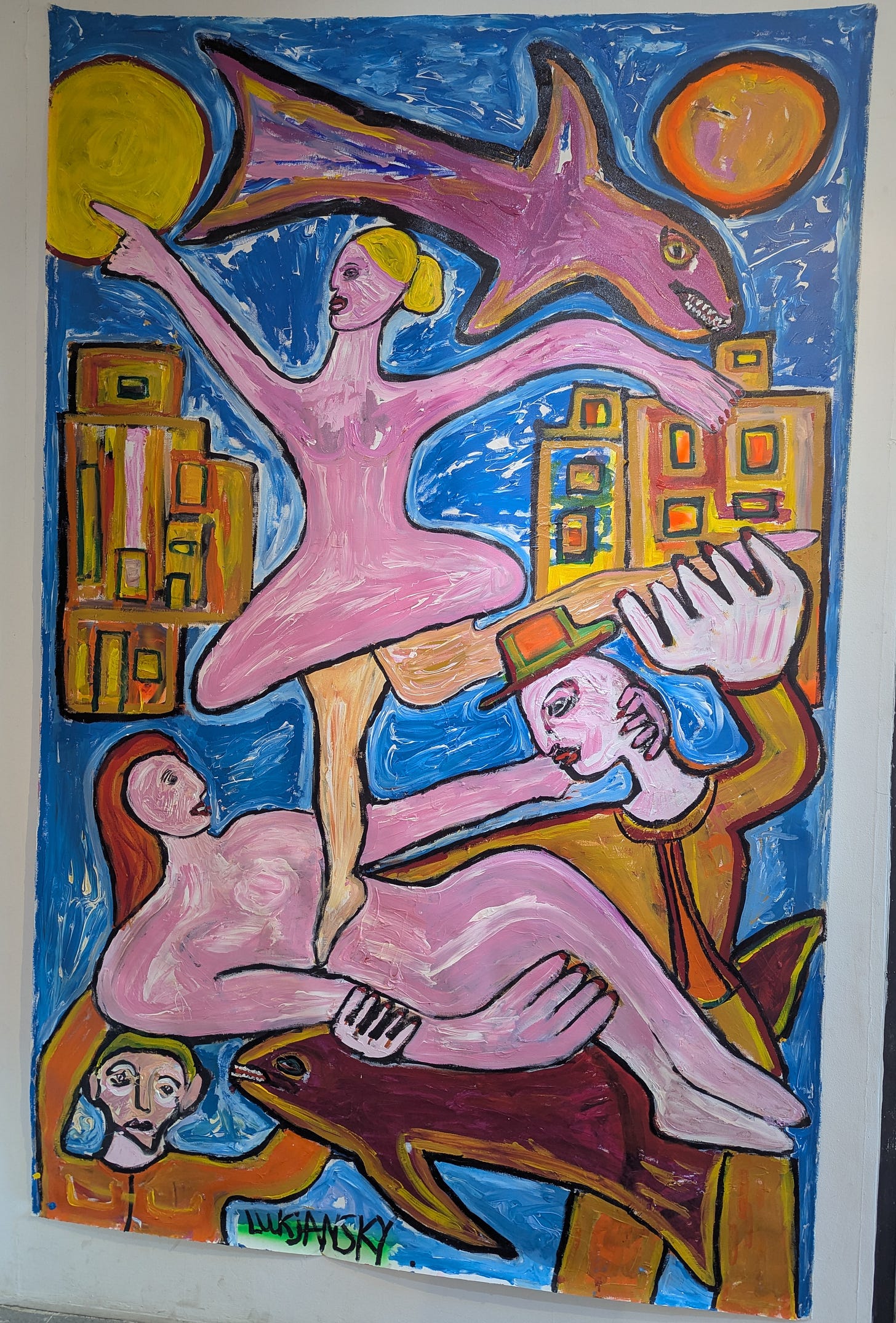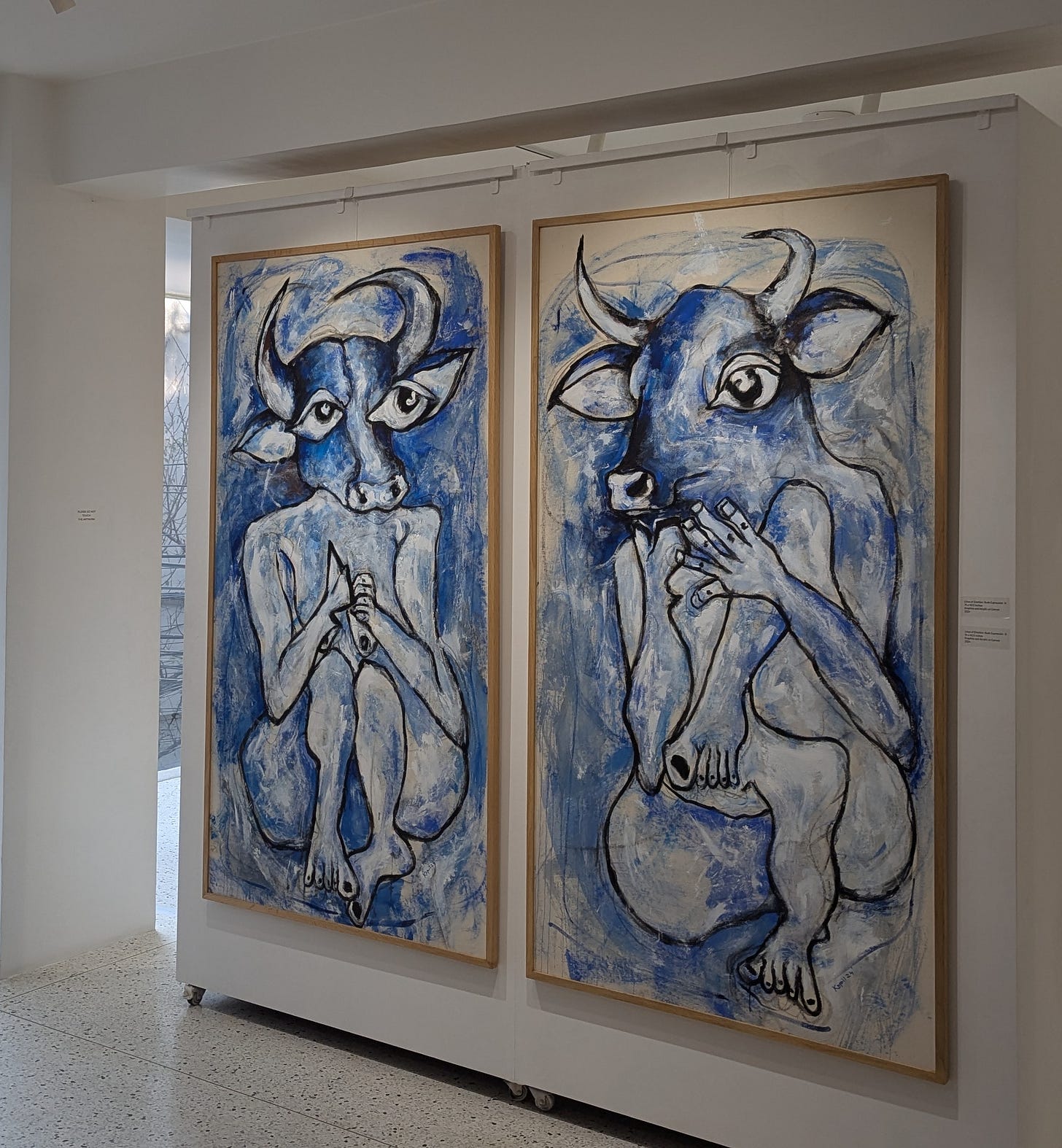“I use the gallery as if it were a doctor. I come for ideas and help.” - Sigmund Freud
A flurry of art openings marked the turn of the year. On the first Saturday of 2025, a hubbub inside Takpa gallery kicked off Kapil Mani Dixit’s “Line of Emotion: Nude Expressions”. Flipping through close-ups and zoom-outs in my smartphone a couple of mornings later, I encounter pieces of art, fragments of colors from various city corners. Vibrant violets, a tangerine background, and broad swathes of burgundy signify Lukjansky’s paintings at Gallery Mcube. Faces larger than life; limbs grasping, holding, swaying inside canvases that covered most of the gallery’s upper and lower walls, output from a residency program.
At Durbar Marg’s Gallery 108, experimental miniatures by Rabi Shrestha: Ganesh and Tara etched in oil and mineral pigments lit up inside small square frames. Down the street, Bijesh Shrestha’s conceptual show at the spanking new Nepal Point is titled Khaldo, or ‘potholes’; the photographs are placed on the floor. The curation mimics a construction zone replete with caution tapes, metal printing sheets and drums. In doing so, the artist invites viewers “to shift our gaze downwards, away from the upward aspirations we typically associate with progress.” Khaldo is anchored by socio political concerns. At the opening, Shrestha implied that Khaldo is also psychological abyss - dark holes of youth despair due to dismal job prospects. The show is a proper counterpoint to Rabi Shrestha’s meticulous drawings which evoke beauty and spirituality. Then I flip back to a screenshot from Takpa’s curatorial introduction and a line stands out: “His work transcends conventional representations of gender and identity, delving deep into the universal concept of the “self”.”
I don’t have an academic background in art history and I’m not a practitioner of fine arts. My interest was sparked primarily by contemporary Nepali artists who came of age during the civil war (1996 - 2006), a period that propelled public consciousness. Due to combined effects of formal studies, faster Internet and frequent migrations, the contemporary art scene in Nepal has steadily gained ground since then. There have also been plays and podcasts, events and festivals aimed to cohere and critique cultural practices. Nepalis making art in Nepal, calling out to other Nepalis, to those in power, to pay attention. Nepalis using emerging techniques, experimenting, exploring, attempting to make a point, to make a mark. Upon encountering this energy - expressed in ink, acrylic, distemper, using metal, wood, fabric - I was viscerally struck.
So I wrote in order to respond - about the value of these dynamic outbursts from the perspective of public education, taking a stance in social justice, emphasizing the need for creativity in a democratic society. In recent months - a pandemic aftereffect perhaps - the frequency and volume of my writing has decreased while I search for new topics, new platforms and new ways to respond.
I’ve been mulling over themes. I’ve interrogated myself regarding intent and purpose. I come across Nobel Laureate Louise Gluck’s ideas in an essay titled, “Writing as Transformation”. Remembering her childhood in a chatty household, she describes how she rarely managed to finish a line of thought while speaking before getting a simplified response, a response which was futile anyway because she hadn’t even articulated her ideas completely. This state of constant incompleteness made her feel somewhat invisible, detached from herself, and a stranger to who she really was. Writing allowed her to search, to seek. The act of writing, she writes, is “a struggle to be, to exist”, the opposite of experiences of extreme bodily pleasure or suffering when one loses the self. In other words, writing allowed Gluck to grasp and clarify the Self in a particular moment in time and place.

Lukjansky’s work “is driven by pure emotional expression, often created spontaneously in the moment, with little premeditated planning”. Dixit’s current collection has also evolved from his previous body of work. The eye is prominent, and so is animality. In some paintings, the eye takes the place of the entire head while in others, the human body has an animal’s head. Our most vulnerable state, that of nakedness, examined with a primal gaze, nudging viewers to gaze at their own selves, our innermost selves so often shrouded under layers of costumes, makeup, job titles, family and social associations. There’s philosophical heft, as well as a dash of mystery, in ‘Line of Expression’. Some paintings are downright abstract, difficult to even decipher outlines. But perhaps that’s the point - sexuality expressed in messy purples, incoherent, loops and dashes and blobs, emptiness here, explosion there, the gender questionable, the identity diffused. No neat lines, no clear labels.
“The self, the place where we live, is a place of illusion,” wrote Iris Murdoch. “Goodness is connected with the attempt to see the unself, to see and to respond to the real world in the light of a virtuous consciousness.” Murdoch negates the idea of a stable, concrete Self, even uplifting the concept by linking it to virtue and morality. For Gluck, the issue is existential, and the act of writing entailed the search for the elusive self, an attempt to assemble herself and make that self temporarily stable and visible on the page. Murdoch maintained that writing is an act of reaching out to the world, presenting an externalized purpose to writing while Gluck claimed that writing primarily served to illuminate one’s inner world. Murdoch implies that the Self is outward-looking, multifarious and evolving whereas for Gluck, due to its amorphous nature, the task is to clarify the Self.

So I visit art galleries, I take pictures, and I think about the Self. I browse through Substack and look over my notes. Since creativity is concerned with both imitation and originality, Rene Girard’s mimetic theory of desire seems pertinent here: “that all desire is merely an imitation of another's desire, and the desire only occurs because others have deemed said object as worthwhile.” There are major implications of this concept for Nepalis, many of whom are still struggling to extricate themselves from the conformist policies of the Panchayat era (1960 - 1990) which still dominates much mainstream discourse. A diverse populace was expected to fit within the narrow standards of a small group of ruling elites. Censorship was high during those thirty years. Unique traditions were abandoned and identities flattened; the education system, controlled by the state’s propaganda, discouraged creativity and critical thinking, all in order to forge a sense of nationalism.
Artists and writers question prevailing norms and think differently. As we go through unprecedented changes and anticipate the impacts of Artificial Intelligence, it is worth asking, Why create? Why write? Sometimes, visiting an art gallery could be the perfect way to brighten short, gray winter afternoons; books and smartphones can be companions during long nights. I mull over memes and reread famous quotes. So I’ll leave you with one by Howard Thurman, “Don't ask what the world needs. Ask what makes you come alive, and go do it. Because what the world needs is people who have come alive.”


